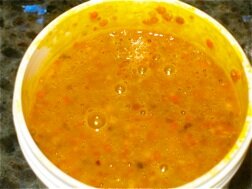As fermented and cultured foods are becoming more popular …being served more in Western restaurants, on store shelves, and home pantries. But one that might not be very familiar is koji rice.
Mainly because it’s a fermented food that’s hiding inside another fermented food.
Today, we will introduce some different ways to use koji rice in recipes and dishes:
– Shio Koji or Koji Salt
– Mock Dry Rub Steak
– Amasake Rice Beverage

Koji rice is steamed rice that has been inoculated with Aspergillus oryzae, a mold that ’s widespread in Japan. The mold releases enzymes that ferment the rice by decomposing its carbohydrates and proteins. This process can also be applied to other
grains like barley or soybeans.
To make koji rice, the mold culture Aspergillus Oryzae is added to the cooked sushi rice. The rice kernels are then placed in wooden trays and left to ferment in a warm, humid environment
for up to 50 hours.
The result is essentially molded rice, but don’t be put off by it immediately. What makes koji so special is that it digests starches and proteins and breaks them down into sugars and amino acids. The taste of the finished malted rice is sweet. Because of this, it can be used as a starter for a number of fermented Japanese food products, including amasake, mirin, sake,
shoyu soy sauce, and miso.

Shio Koji (塩麹, 塩糀) – A century-old natural seasoning used in Japanese cooking to marinate, tenderize, and enhance umami flavor of a dish.
It’s made of just a few simple ingredients: salt, water, and rice koji.
You can use shio koji to marinade meats, make pickles, flavor your vegetables or use it as a salt substitute. In a recipe that calls for one teaspoon of salt, you can substitute with 2 teaspoons of shio-koji. Shio-koji is really versatile and can be used in any kind of cooking.

~ Benefits of Shio Koji ~
Because it is a fermented ingredient, shio koji is known for its many health benefits, which includes:
- A natural pro-biotic seasoning
- Tenderizes food
- Brings out the umami and sweetness in foods
- Reduces the intake of salt
- Aids in digestion
- Clear the skin
- Anti-aging
- Contains minerals, fiber and vitamins
Shio Koji Recipe
What is needed to get started…
– 375g fresh koji rice
– 110g sea salt, 30% of the weight of the koji
– 560ml good quality water
First, wash your hands and sanitize a glass or metal container. Then rub the koji rice and salt between the hands mixing thoroughly.
Add the water to the shio and stir.

Cover and keep in a warm place around 27 to 37 Deg C. Stir twice a day for 1 to 2 weeks. The amount of time can vary with the summer or winter temperature.
Now you can use the shio koji rice in many Japanese style dishes. You can marinade meats, make pickles, or just use your shio-koji as a salt substitute. Shio-koji is incredibly versatile and can be used in any kind of cooking. It will keep in the refrigerator for a good amount of time remembering to label & date. – Fin
~ Mock Dry-Aged Shio Koji Steak ~
Here’s a quick way of dry aging a steak without the time or higher prices for real dry aged. This method seems to be taking storm in the USA.
Dry-aged meat is amazing and certainly worth buying when you can afford it. However, a “mock” dry aging that tastes just as good as dry-aged meat, for a considerably smaller price tag and shorter time frame.


What is Needed…
– Steak, any cut desired, cheaper cuts seem to be a better deal.
– Koji rice, enough to cover the steak, purchase here or make your own koji rice.
– Time of about 2 to 3 days
Start by prepping and trimming the steak, if needed. The koji rice can be ground up into a powder or left as whole grains. Rub all sides of the meat (Use cheaper steak cuts for best results) generously and then let it sit uncovered on a wire rack in the fridge for 2-3 days. Don’t allow to sit too long or the meat starts to get too tough and begins to almost cure. After 12 hours, the meat starts to look like a moist, snow-covered slab of steak. The aroma is just as rich and nutty with a touch of sweetness, just as a steak that’s been dry-aging for over a month.

Before cooking, rinse the meat thoroughly in cold water to remove all the koji, then pat dry. Next, season the meat with salt and sear it in a cast-iron pan or cook normally. The dry-aged rubbed steak will caramelize and pick up color much faster than a normal steak. – Fin
~ Sweet Amasake Rice Beverage ~
Used in Japan as a sweetener, beverage, or a simple alcoholic drink. Amazake is one of the best known cultured and fermented items from Japan. There are several recipes for amazake that have been used for hundreds of years. By a popular recipe, kōji is added to cooled whole grain rice causing enzymes to break down the carbohydrates into simpler unrefined sugars. As the mixture incubates, sweetness develops naturally. By another popular recipe, sake kasu is simply mixed with water, but usually, sugar is added.
In this recipe, amazake becomes low-alcohol beverage if given time.

Amazake can be used as a dessert snack, natural sweetening agent, food for infants, added in salad dressing or smoothies. The traditional drink (prepared by combining amazake and water, heated to a simmer, and often topped with a pinch of finely grated ginger) was popular with street vendors. It is still served at inns, tea houses, and at festivals.
Many Shinto shrines in Japan provide or sell it during the New Year!

What is Needed…
– 3c cooked brown rice
– 1c of malted koji rice. If koji rice is needed…order here
Yield: 4 cups of fermented rice to use as a sweetener or 3 quarts Amazaké drink
Incubation Temperature: 120-140 F (50-60C)

Start by cooking the brown rice and allowing it to cool to at least 120 F (50C). Once cooled, stir in the koji rice and mix well. Place mixture into a glass or stainless steel container that will allow an inch of “headroom” to allow for expansion during the fermentation process. Cover container and incubate, stirring every couple of hours to prevent heat buildup. The finished product can take as little as 6 hours with quality, fresh (not dried) koji-kin at optimum temperatures after 6 hours start tasting the ferment to see if the cycle is complete.
When finished the ferment should thicken like porridge with a mild sweet taste. The sweetness will increase up to a point after which it will change and start to become sour. Once the taste is to your liking, place into a saucepan and bring to a boil. Reduce the heat and simmer for 3 to 5 min., stirring frequently. Boiling will stop the fermentation process keeping the amazaké sweet. For a smother amazaké consistency purée the mixture in a blender until smooth. Refrigerate any ferment not used right away. If not, the amazaké will become very sour. A little fresh ground ginger may also be added.
Use the finished product to make a non-sugar sweetener, a beverage, even a simple grog called, Doburoku ( どぶろく or 濁酒 ).
– Fin
We hope you have enjoyed finding new ways of using fermented and cultured foods. See our store for more items like rice koji, spores, and accessories. Store.Organic-Cultures.Com


 Rose hips harvested after the first frost also contains wild yeast and/or bacteria. Any type of wild edible berry will contain the yeast and bacteria needed for making fermented beverages.
Rose hips harvested after the first frost also contains wild yeast and/or bacteria. Any type of wild edible berry will contain the yeast and bacteria needed for making fermented beverages. – Organic grapes, plums, fruits that have a white bloom.
– Organic grapes, plums, fruits that have a white bloom. – Blackberries/Raspberries
– Blackberries/Raspberries There are other items found in nature that allows for fermentation. Pollen from flowers contains wild yeast, so many are used for culturing pro-biotic drinks. Massive amounts of yeast are within the bee pollen from the array of flowers that the bees have collected.
There are other items found in nature that allows for fermentation. Pollen from flowers contains wild yeast, so many are used for culturing pro-biotic drinks. Massive amounts of yeast are within the bee pollen from the array of flowers that the bees have collected. Super – Pollen – D’Probiotica
Super – Pollen – D’Probiotica The Butterfly
The Butterfly Wild Nettle or Dandelion, Raw Bee Pollen, & Raw Honey Kraut
Wild Nettle or Dandelion, Raw Bee Pollen, & Raw Honey Kraut













 Having a traditional starter culture ensures the same results each time. An example is making beer with wild yeast vs. using a brewers yeast. The outcome could be close in taste and flavor to each other or very different, with the wild yeast sometimes making the beer unpalatable. Having a tried and true recipe helps to make sure the results are the same every time, too. Checking acidic levels and having the correct microorganisms, like lactobacillales, ensure cultured food safety.
Having a traditional starter culture ensures the same results each time. An example is making beer with wild yeast vs. using a brewers yeast. The outcome could be close in taste and flavor to each other or very different, with the wild yeast sometimes making the beer unpalatable. Having a tried and true recipe helps to make sure the results are the same every time, too. Checking acidic levels and having the correct microorganisms, like lactobacillales, ensure cultured food safety.


 Tempeh is made from cooked and slightly fermented soybeans and formed into a cake, similar to a very firm veggie burger. Traditional tempeh is a soybean cake that has a rich smoky flavor and aroma, with a firm nutty texture. The soybeans are fermented and inoculated with the mold spores of Rhizopus oligosporus. Use the cooked TPS cakes as a replacement for meat in many recipes.
Tempeh is made from cooked and slightly fermented soybeans and formed into a cake, similar to a very firm veggie burger. Traditional tempeh is a soybean cake that has a rich smoky flavor and aroma, with a firm nutty texture. The soybeans are fermented and inoculated with the mold spores of Rhizopus oligosporus. Use the cooked TPS cakes as a replacement for meat in many recipes. Tempeh is fermented soy food that originated on the island of Java in Indonesia and is fermented with the mold
Tempeh is fermented soy food that originated on the island of Java in Indonesia and is fermented with the mold Making tempeh is not a hard process for those with some cooking skills or background. The basics are boiling and de-hauling the soybeans, letting this cooldown, and inoculate the cooked soybeans with the tempeh spores. The finished result is a firm white cake ready to slice and cook.
Making tempeh is not a hard process for those with some cooking skills or background. The basics are boiling and de-hauling the soybeans, letting this cooldown, and inoculate the cooked soybeans with the tempeh spores. The finished result is a firm white cake ready to slice and cook.